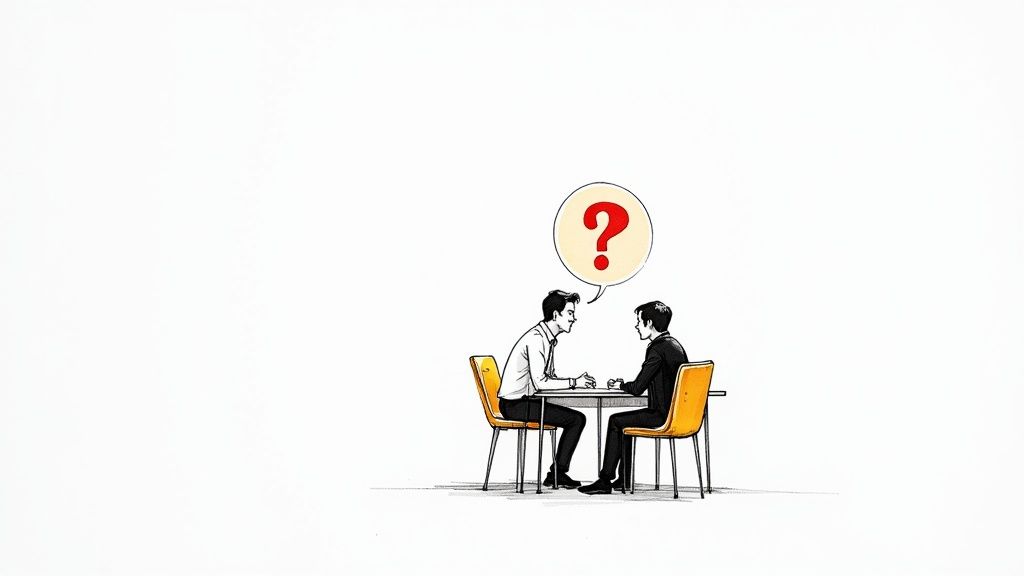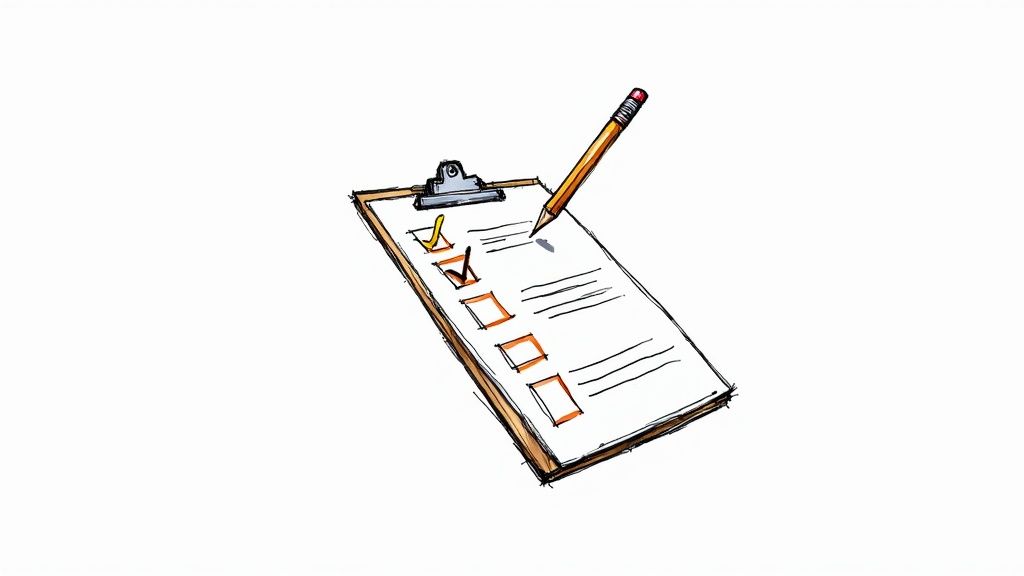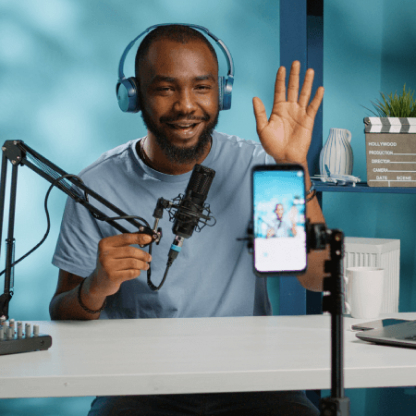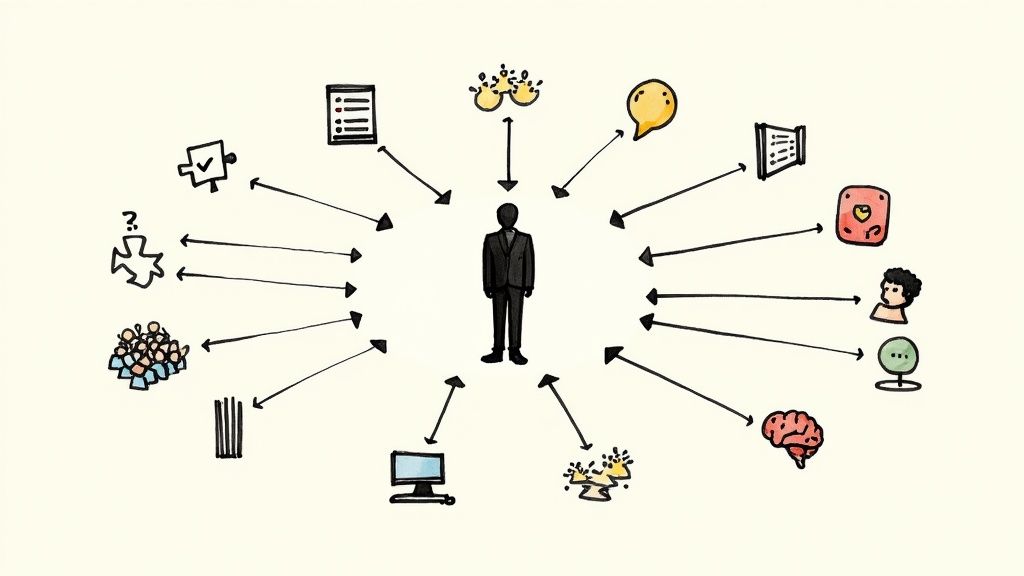Let's be real. Your go-to preliminary interview questions are probably a recycled list you snagged from a quick Google search. You ask, "Where do you see yourself in five years?" and get a canned answer they also found online. It’s a pointless song and dance that wastes everyone’s time. And frankly, it's why you keep making bad hires.
Why Your Current Interview Process Is Broken (And How to Fix It)
We've all been there. You're on a 15-minute call, desperately hoping it will magically unearth a superstar performer. But here's the hard truth: hope is not a hiring strategy. It's time to admit the old way of screening is fundamentally broken. The real problems run deep, from asking leading questions to putting way too much faith in a polished resume.
I've learned this lesson the hard way. I've made painful hires who looked incredible on paper but were a complete mismatch in reality. Why? Because our initial screening was just a box-ticking exercise. It did nothing to predict how they'd actually perform on the job.
The Numbers Don't Lie
Most initial screening calls are superficial and way too short, leading to decisions that are little better than a coin flip. A quick glance at the data just confirms what we all feel in our gut.

The data confirms the madness. We spend just enough time to cover the absolute basics, yet we end up advancing more than half the candidates. That alone proves the process isn't selective; it's just a leaky sieve letting mediocrity flow into your pipeline.
Traditional vs Modern Screening: Where Your Time Really Goes
It's easy to think the old way is faster, but when you break it down, you see where the hours really disappear. Hope you enjoy spending your afternoons fact-checking resumes—because that’s now your full-time job.
| Screening Activity | Traditional Approach (The Time Sink) | Modern Approach (The Fix) |
|---|---|---|
| Scheduling | Endless back-and-forth emails, chasing down candidates, and playing calendar Tetris. A soul-crushing time suck. | Candidates self-schedule from available slots or complete on-demand tasks. Done. |
| The "Interview" | A 15-30 minute live call spent on repetitive, basic qualification questions. Snooze. | An automated or structured task that tests a core skill upfront, no live call needed. |
| Review & Decision | Gut feelings and fuzzy notes from a quick call. Translation: bias and guesswork. | Reviewing standardized, objective results. Comparing apples to apples, not apples to vibes. |
| Time Investment | 30-60 minutes per candidate, often for a low-quality outcome. | 5-10 minutes per candidate for a data-backed decision. You do the math. |
The difference is stark. A modern approach doesn't just save time; it forces a more disciplined and objective evaluation from the very start.
Stop the Madness, Build a Better System
The goal here isn't just to ask a few cleverer questions. It's about overhauling the entire system. You need a process that reveals how someone thinks, solves real problems, and handles the messy reality of the job—not just how well they can rehearse answers.
For any organization that feels stuck in this inefficient cycle, exploring comprehensive strategies to improve your recruitment process is the first step toward building a real talent pipeline.
The most expensive mistake isn't a bad hire—it's having a broken process that produces them again and again. You're not just losing payroll; you're losing momentum, morale, and your best people's time cleaning up the mess.
It’s time to stop the madness and design a screening process that actually screens. That means moving beyond generic preliminary interview questions and digging into what truly predicts success in a role.
Embracing the New Reality of Virtual Interviews

Remember when interviews meant firm handshakes and navigating an unfamiliar office to find the right meeting room? Those days are largely behind us. The pivot to virtual and asynchronous interviews isn't just a temporary workaround—it’s the new standard for modern hiring.
This is more than just swapping a conference room for a Zoom call. It represents a fundamental shift in how we identify genuine talent. Suddenly, you have access to a global talent pool, which is fantastic… until you realize your preliminary interview questions need to be sharper than ever to cut through the digital noise.
The Asynchronous Screen is Here to Stay
Let's be clear: hiring has moved online for good. A significant number of employers—over half, in fact—now kick off their process with online interviews. Many are leaning into asynchronous video assessments where candidates record their answers on their own time. While this opens up a world of talent, it also means a candidate's digital fluency is now a non-negotiable skill.
This isn’t about making candidates jump through more hoops. It's about designing a process that respects their schedule while giving you a raw, unfiltered glimpse into their communication style and thought process.
Forget "Tell me about yourself." The new first question is often, "Can you follow instructions and record a clear, concise video?" It's a surprisingly effective filter for attention to detail and professionalism.
This new reality demands a new playbook. Turns out there’s more than one way to hire elite developers without mortgaging your office ping-pong table. The key is to find platforms that actually streamline your workflow, not just expensive gadgets that add another layer of complexity.
If you're just dipping your toes into this world, brushing up on some foundational virtual interview tips is a great first step to get your bearings.
Crafting Questions That Reveal Skills Not Scripts

Let's be brutally honest. If you ask, "What's your greatest weakness?" you're just signing up to hear a well-rehearsed speech about perfectionism. You know it, they know it, and it's a colossal waste of everyone's time. The real goal of your preliminary interview questions isn't to play "gotcha" but to get candidates off-script. You need to see how they really think.
A truly great question forces a candidate to stop reciting their resume and start providing evidence of their skills. It peels back the polished exterior to reveal how they solve problems, handle pressure, and navigate the messy reality of the workplace.
From Vague to Valuable
It's time to get tactical. The trick is to replace lazy, abstract questions with ones that demand concrete examples from their actual work history. This isn't just about having a better conversation; it's about building a repeatable interview kit that's fair, insightful, and actually helps predict who will succeed.
Stop asking garbage like this:
- "Are you a good communicator?"
- "How do you handle stress?"
- "Are you a self-starter?"
Instead, make them prove it with questions like these:
- "Tell me about a time you had to explain a complex technical issue to a non-technical stakeholder. How did you approach it, and what was the outcome?"
- "Describe the most high-pressure situation you’ve faced at work in the last year. What was the context, and what specific steps did you take to manage it?"
- "Walk me through a project you initiated and led from start to finish. Where did the idea come from, and how did you get it across the finish line?"
The best preliminary interview questions are mini-case studies. They don’t have a single “right” answer, but they reveal everything about a candidate’s process, resilience, and problem-solving abilities.
The Acid Test Questions for Key Roles
Over the years, I've developed a few go-to questions tailored for specific roles. These aren't magic bullets, but they cut through the fluff with brutal efficiency.
For a Sales Role, I always ask: "Tell me about a deal you lost. What happened, and what did you learn?" If they start blaming the product, the price, or the prospect, it’s a huge red flag. But if they own it and can articulate what they changed in their process because of it, I'm definitely paying attention.
For a Marketing Role, I'll try: "Describe a campaign that completely flopped. Why did it fail, and what data told you it was failing?" This tests two critical marketing traits at once: their humility and their relationship with data.
When it comes to an Engineering Role, the technical screen is obviously a massive part of the process. You have to move beyond hypotheticals and into challenges that mirror the actual work they'll be doing. For a deeper dive, check out these proven strategies for technical interviews, including those for Node.js developers. This is where you can truly evaluate their real-world coding and problem-solving chops.
How Structured Interviews Protect You From Bad Hires

If you're still winging your preliminary interviews and banking on "gut feeling," you might as well be gambling with your company's payroll. Gut feelings are notoriously biased, inconsistent, and terrible predictors of actual job performance.
The antidote? Structured interviews. I know, it sounds painfully corporate and bureaucratic, but it’s your single greatest weapon against hiring mistakes.
No HR Jargon, Just a Better System
So, what does "structured" even mean in the real world? It's simple: you ask every candidate for a specific role the exact same core questions and score their answers against the exact same predefined criteria.
That’s it. This simple discipline is incredibly powerful because it forces you to define what “good” actually looks like before you even talk to anyone. This dramatically reduces the "I just liked their vibe" bias that dooms so many hires.
A structured interview isn't about being rigid; it's about being fair. You’re swapping random conversations for a reliable system that compares every candidate on the metrics that actually matter for the job.
This approach also saves a ridiculous amount of time. Recruiters can spend a whopping 35% of their time just scheduling calls. Automated scheduling and asynchronous video interviews can slash shortlisting time by up to 75% and are twice as predictive as old-school unstructured chats. To see how this transforms the hiring funnel, you can explore the top hiring trends here.
Implementing this doesn't require a team of HR specialists. You can build a simple but effective system with a clear set of preliminary interview questions and a straightforward scorecard. To get started, you can even check out our guide on creating a solid interview evaluation form. This simple document is the first step toward building a hiring machine that consistently finds great people.
When you start hiring from around the globe, your old playbook gets tossed out the window. Suddenly, you're not just dealing with different cities, but different continents, cultures, and time zones. Sticking to a single, rigid process is a surefire way to lose out on fantastic candidates simply because your system wasn't built for their reality.
It’s a balancing act. You need to be fast and flexible where you can, but still methodical where it counts. This means rethinking everything from your preliminary interview questions to your entire hiring timeline.
One Process Does Not Fit All
Ignoring global differences is a rookie mistake I’ve seen too many times. For instance, did you know that the time it takes to complete an interview process can vary wildly from one country to another? In Brazil, it can take an average of nearly 40 days, while in the UK, it’s closer to 28. Some academic roles might drag on for two months, but a job in hospitality could be filled in less than ten days. You can dig into more of these interview timeline statistics to see just how much it can fluctuate.
So, what does this mean for you? Setting crystal-clear timeline expectations is no longer a "nice-to-have"—it's non-negotiable. If you’re hiring in a country known for quick turnarounds, a slow, multi-stage process will make you look indecisive. You'll lose your best people to competitors who can move faster.
The new golden rule of global hiring: Adapt or lose. Your ideal candidate in another time zone won't wait around while you stick to a process designed for your local office.
Managing this kind of complexity without breaking the bank requires the right tools. Technology is the great equalizer here, bridging the gaps created by time zones and communication styles. For example, on-demand video interviews let candidates record their answers when it’s convenient for them, not at 3 AM their time.
Using technology for automated candidate screening is how you build a pipeline that can actually handle a global talent flow. This is how you create a system that’s fair to every applicant and efficient for your team, no matter where they are. It’s how you win the best talent, period.
Common Questions About Preliminary Interviews
Alright, let's tackle the nagging questions that always come up when you start to really fix your hiring funnel. These are the things people often wonder but are too afraid to ask. No fluff, just straight answers from someone who's been in the trenches.
How Long Should a Preliminary Interview Be?
Forget the hour-long chat. Your preliminary interview should be ruthlessly efficient—think 20 to 30 minutes, max. The goal isn't to hear their life story; it's to validate their core qualifications and see if there’s a basic alignment.
Anything longer and you're just being inefficient. Respect your time, and more importantly, respect the candidate's time.
Should I Share Questions With Candidates Beforehand?
For behavioral or situational questions—the "Tell me about a time when…" type—the answer is a hard yes. This isn't a pop quiz or a memory test. You want to see their best, most thoughtful self, not watch them fumble for a half-baked example on the spot.
Sharing the questions beforehand helps them prepare real, evidence-based answers. This leads to a much richer conversation and gives you a far better signal of their actual capabilities.
What's the Biggest Red Flag to Watch For?
Vagueness. A lack of specific, concrete examples is the single biggest red flag in a preliminary interview. If a candidate only talks in generalities ("I'm a great communicator" or "I'm a real team player") but can't back it up with a real story, something's wrong.
Vague answers are a smokescreen. They almost always hide a lack of real experience, a failure to take ownership, or an inability to articulate their own accomplishments. Don't fall for it.
Can I Really Assess Cultural Fit in 20 Minutes?
No, and you shouldn't try. Honestly, "cultural fit" is a dangerous metric that often just leads to hiring people who look and think just like you. Instead, you should screen for "culture adds" and obvious misalignments.
Ask questions that reveal their preferred work style, how they handle direct feedback, and what kind of environment helps them do their best work. Focus on shared values and productive behaviors, not whether you'd want to have a beer with them.
Ready to stop wasting time on bad interviews and start hiring smarter? Async Interview gives you the tools to automate your initial screening, evaluate candidates fairly, and build a hiring process that consistently finds top talent. We’re not saying we’re perfect. Just more accurate more often. (Toot, toot!) Ditch the scheduling chaos and see for yourself at https://asyncinterview.io.




